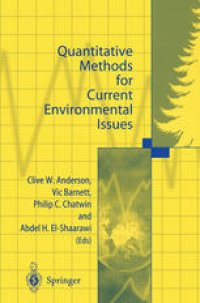
Ebook: Quantitative Methods for Current Environmental Issues
- Tags: Statistical Theory and Methods, Math. Appl. in Environmental Science, Statistics for Engineering Physics Computer Science Chemistry and Earth Sciences, Applications of Mathematics
- Year: 2002
- Publisher: Springer-Verlag London
- Edition: 1
- Language: English
- pdf
It is increasingly clear that good quantitative work in the environmental sciences must be genuinely interdisciplinary. This volume, the proceedings of the first combined TIES/SPRUCE conference held at the University of Sheffield in September 2000, well demonstrates the truth of this assertion, highlighting the successful use of both statistics and mathematics in important practical problems.
It brings together distinguished scientists and engineers to present the most up-to-date and practical methods for quantitative measurement and prediction and is organised around four themes:
- spatial and temporal models and methods;
- environmental sampling and standards;
- atmosphere and ocean;
- risk and uncertainty.
Quantitative Methods for Current Environmental Issues is an invaluable resource for statisticians, applied mathematicians and researchers working on environmental problems, and for those in government agencies and research institutes involved in the analysis of environmental issues.
It is increasingly clear that good quantitative work in the environmental sciences must be genuinely interdisciplinary. This volume, the proceedings of the first combined TIES/SPRUCE conference held at the University of Sheffield in September 2000, well demonstrates the truth of this assertion, highlighting the successful use of both statistics and mathematics in important practical problems.
It brings together distinguished scientists and engineers to present the most up-to-date and practical methods for quantitative measurement and prediction and is organised around four themes:
- spatial and temporal models and methods;
- environmental sampling and standards;
- atmosphere and ocean;
- risk and uncertainty.
Quantitative Methods for Current Environmental Issues is an invaluable resource for statisticians, applied mathematicians and researchers working on environmental problems, and for those in government agencies and research institutes involved in the analysis of environmental issues.
It is increasingly clear that good quantitative work in the environmental sciences must be genuinely interdisciplinary. This volume, the proceedings of the first combined TIES/SPRUCE conference held at the University of Sheffield in September 2000, well demonstrates the truth of this assertion, highlighting the successful use of both statistics and mathematics in important practical problems.
It brings together distinguished scientists and engineers to present the most up-to-date and practical methods for quantitative measurement and prediction and is organised around four themes:
- spatial and temporal models and methods;
- environmental sampling and standards;
- atmosphere and ocean;
- risk and uncertainty.
Quantitative Methods for Current Environmental Issues is an invaluable resource for statisticians, applied mathematicians and researchers working on environmental problems, and for those in government agencies and research institutes involved in the analysis of environmental issues.
Content:
Front Matter....Pages i-x
Front Matter....Pages 1-1
Modeling Spatio-Temporally Misaligned Areal and Point Process Environmental Data....Pages 3-35
Space and Space-Time Modeling using Process Convolutions....Pages 37-56
Multivariate Kriging for Interpolating with Data from Different Sources....Pages 57-75
Front Matter....Pages 77-77
Distance Sampling: Recent Advances and Future Directions....Pages 79-97
Setting Environmental Standards: A Statistical Approach....Pages 99-109
Front Matter....Pages 111-111
The Interpretation and Validation of Measurements of the Ocean Wave Directional Spectrum....Pages 113-128
Thermal Energy Emission and Propagation from Accidents....Pages 129-146
Development and Application of an Extended Methodology to Validate Short-Range Atmospheric Dispersion Models....Pages 147-165
Uncertainty and Sensitivity of Dispersion Model Results to Meteorological Inputs: Two Case Studies....Pages 167-203
Front Matter....Pages 205-205
Statistics and the Environmental Sciences: Approaches to Model Combination....Pages 207-226
Bayesian Analysis of Computer Code Outputs....Pages 227-243
The Realities of Decision Making on Risks....Pages 245-264
Back Matter....Pages 265-270
It is increasingly clear that good quantitative work in the environmental sciences must be genuinely interdisciplinary. This volume, the proceedings of the first combined TIES/SPRUCE conference held at the University of Sheffield in September 2000, well demonstrates the truth of this assertion, highlighting the successful use of both statistics and mathematics in important practical problems.
It brings together distinguished scientists and engineers to present the most up-to-date and practical methods for quantitative measurement and prediction and is organised around four themes:
- spatial and temporal models and methods;
- environmental sampling and standards;
- atmosphere and ocean;
- risk and uncertainty.
Quantitative Methods for Current Environmental Issues is an invaluable resource for statisticians, applied mathematicians and researchers working on environmental problems, and for those in government agencies and research institutes involved in the analysis of environmental issues.
Content:
Front Matter....Pages i-x
Front Matter....Pages 1-1
Modeling Spatio-Temporally Misaligned Areal and Point Process Environmental Data....Pages 3-35
Space and Space-Time Modeling using Process Convolutions....Pages 37-56
Multivariate Kriging for Interpolating with Data from Different Sources....Pages 57-75
Front Matter....Pages 77-77
Distance Sampling: Recent Advances and Future Directions....Pages 79-97
Setting Environmental Standards: A Statistical Approach....Pages 99-109
Front Matter....Pages 111-111
The Interpretation and Validation of Measurements of the Ocean Wave Directional Spectrum....Pages 113-128
Thermal Energy Emission and Propagation from Accidents....Pages 129-146
Development and Application of an Extended Methodology to Validate Short-Range Atmospheric Dispersion Models....Pages 147-165
Uncertainty and Sensitivity of Dispersion Model Results to Meteorological Inputs: Two Case Studies....Pages 167-203
Front Matter....Pages 205-205
Statistics and the Environmental Sciences: Approaches to Model Combination....Pages 207-226
Bayesian Analysis of Computer Code Outputs....Pages 227-243
The Realities of Decision Making on Risks....Pages 245-264
Back Matter....Pages 265-270
....